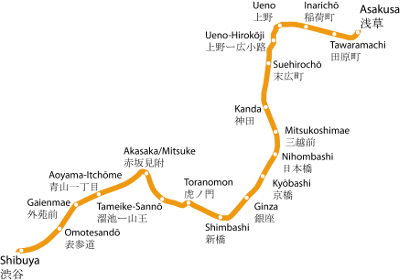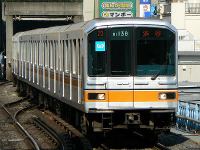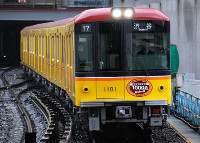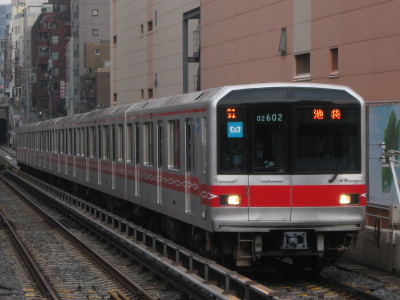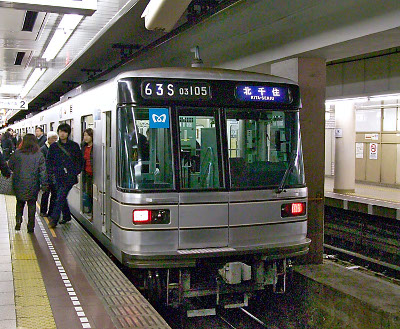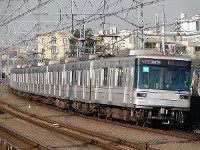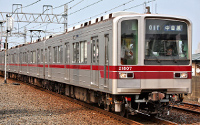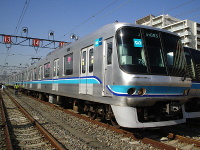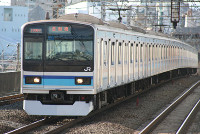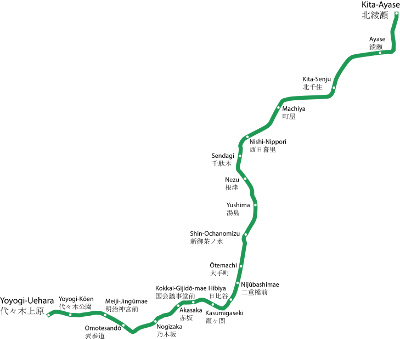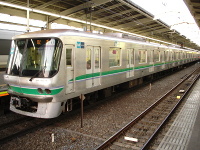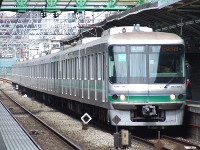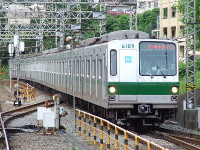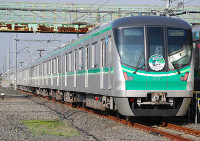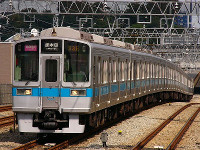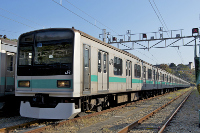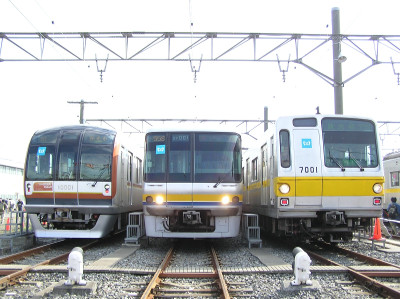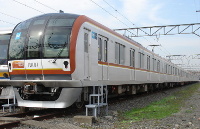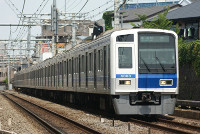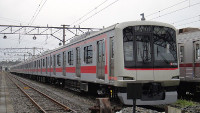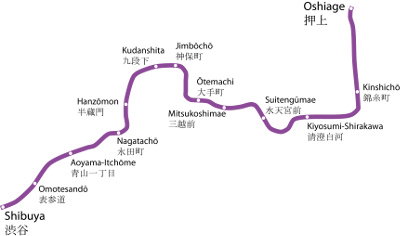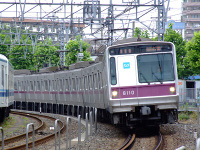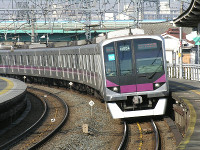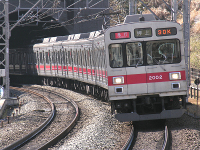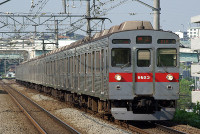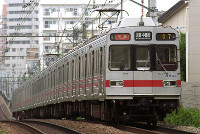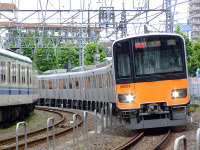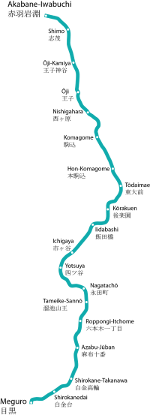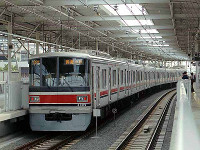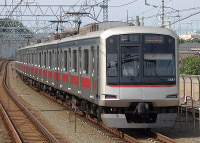Tokyo Metro Lines
This is the page for all Tokyo Metro Lines
- Ginza Line
- Marunouchi Line
- Hibiya Line
- Tōzai Line
- Chiyoda Line
- Yūrakuchō Line
- Hanzōmon Line
- Namboku Line
- Fukutoshin Line
Ginza Line

Tokyo Metro Ginza Line 01 Series EMUs at Shibuya Station
LocaleTokyo
TerminiShibuya and Asakusa Stations19 Daily ridership1,006,102 (2010)
OwnerTokyo Metro
DepotsShibuya, Ueno
Rolling StockTokyo Metro 01 Series, Tokyo Metro 1000 Series
Track Gauge1,435 mm (4 ft 8.5 in)
Electrification600 V DC, third rail
Operating Speed65 km/h (40 mph)
The Tokyo Metro Ginza Line (東京地下鉄銀座線 Tōkyō Chikatetsu Ginza-sen) is a subway line in Tokyo, Japan. It is part of the of Tokyo Metro network. The official name is Line 3 Ginza Line (3号線銀座線 3-gōsen Ginza-sen). It is 14.3 km long and serves the wards of Shibuya, Minato, Chūō, Chiyoda, and Taitō. The line holds the distinction of being the oldest subway line in Asia. On maps, diagrams and signboards, the line is shown using the color orange, and its stations are given numbers using the letter G. The subway has a third rail power source (With that it's 1 of the 2 subway lines that have a thrid rail power source, all other subway lines have overhead power). During the weekdays the Ginza Line operates every 2 minutes in peak hours, every 2 minutes and 15 seconds in evening peak hours and every 3 minutes in the dayhours.
History
The Ginza Line was conceived by a businessman named Noritsugu Hayakawa, who visited London in 1914, saw the London Underground and concluded that Tokyo needed its own underground railway. He founded the Tokyo Underground Railway (東京地下鉄道 Tōkyō Chika Tetsudō) in 1920, and began construction in 1925.
On January 1, 1930, the subway was extended by 1.7 km to temporary Manseibashi Station, abandoned on November 21, 1931 when the subway reached Kanda, 500 meters further down south the line. The Great Depression slowed down construction, but the line finally reached its originally planned terminus of Shinbashi on June 21, 1934.
In 1938, the Tōkyō Rapid Railway (東京高速鉄道 Tōkyō Kōsoku Tetsudō), a company tied to the predecessor of today's Tokyu Corporation, began service between Shibuya and Toranomon, later extended to Shinbashi in 1939. The two lines began through-service interoperation in 1939 and were formally merged as the Teito Rapid Transit Authority ("Eidan Subway" or "TRTA") in July 1941.
The "Ginza Line" name was applied in 1953 to distinguish the line from the new Marunouchi Line. In the postwar economic boom, the Ginza Line became increasingly crowded. The new Hanzōmon Line began to relieve the Ginza Line's traffic in the 1980s, but the Ginza Line is still quite crowded as it serves major residential, commercial, and business districts in central Tokyo. According to a June 2009 Tokyo Metropolitan Bureau of Transportation survey, the Ginza Line is the seventh most crowded subway line in Tokyo, running at 168% capacity between Akasaka-Mitsuke and Tameike-Sannō stations.
The newest station on the line, Tameike-Sannō Station, opened in 1997 to provide a connection to the newly built Namboku Line.
Station List
Here is the station list of the Ginza Line from Shibuya (for transfers to other lines look at the page of the station).
- Shibuya
- Omotesando
- Gaiemmae
- Aoyama Itchome
- Akasaka Mitsuke
- Tameike Sanno
- Toranomon
- Shinbashi
- Ginza
- Kyobashi
- Nihonbashi
- Mitsukoshimae
- Kanda
- Suehirocho
- Ueno Hirokoji
- Ueno
- Inaricho
- Tawaramachi
- Asakusa
Current Rolling Stock
The Ginza Line uses a total of 38 six-car 01 Series EMUs which have a maximum speed of 80 km/h. Each car is 16 m long and 2.6 m wide, with three doors on each side. Both the Ginza Line and the Marunouchi Line run on 1,435 mm (4 ft 8 1⁄2 in) standard gauge, powered by a 600 V DC third rail, while the other Tokyo Metro lines run on narrow gauge (1,067 mm (3 ft 6 in)) rails and use 1,500 V DC overhead.
New 1000 Series EMUs entered service on the line from April 2012.
Cars are stored and inspected at Shibuya Depot located after Shibuya Station and at Ueno Inspection Division (上野検車区 Ueno-kensha-ku), a facility located northeast of Ueno Station with both above-ground and underground tracks. The facility is capable of holding up to 20 6-car formations. Major inspections are carried out at Tokyo Metro's Nakano depot on the Marunouchi Line, forwarding over a connecting track at Akasaka-Mitsuke.
Marunouchi Line
The Tokyo Metro Marunouchi Line (東京地下鉄丸ノ内線 Tōkyō Chikatetsu Marunouchi-sen) is a subway line of the Tokyo Metro system in Tokyo, Japan. The line runs in a U-shape between Ogikubo Station in Suginami and Ikebukuro Station in Toshima, with a branch line between Nakano-Sakaue Station and Hōnanchō Station. The official name is Line 4 Marunouchi Line (4号線丸ノ内線 Yon-gōsen Marunouchi-sen). The Marunouchi Line is one of the 2 third rail lines of the Tokyo Metro Subway company. All other lines have overhead power.
Overview
The Marunouchi Line is the second line to be built in the city, and the first one constructed after the Second World War. The route is U-shaped, running from Ogikubo Station in the west of the city via the commercial and administrative district of Shinjuku through to the Marunouchi commercial center around Tokyo Station, before turning back and heading to Ikebukuro.
The Marunouchi Line is served by Tokyo Metro 02 Series rolling stock in six-car trains on the main line, and three-car trains on the Hōnanchō branch. The main line is the most frequent subway line in Tokyo, with trains running at intervals of 1 minute 50 seconds during peak hours. In spite of such high-frequency service, according to a 2008 survey by the Ministry of Land, Infrastructure, Transport and Tourism the Marunouchi Line is one of the most crowded railway lines in Tokyo, running at 157% capacity between Shin-ōtsuka and Myōgadani stations. Its age and relatively short train length has made it one of the most crowded lines in Tokyo, although the 2000 opening of the Toei Ōedo Line has relieved the problem somewhat. In response to crowding, Tokyo Metro upgraded all stations with chest-high platform doors on March 28, 2009, a date on which it also began driver-only operation . The Hōnanchō branch switched to driver-only operation in July 2004.
Due to the age of the Marunouchi Line and the relative shallowness at which it runs, at several points in central Tokyo trains run at or above ground level. These include Yotsuya Station, the Kanda River near Ochanomizu Station (see image), and between Kōrakuen and Myōgadani stations.
On maps, diagrams and signboards, the line is shown using the color "red". Its stations are given numbers using the letter M; Hōnanchō branch line stations carry a lowercase m.
History
The Marunouchi Line is the second subway line to be built in the city, and the first to be constructed after the Second World War. Its design is similar to that of the Ginza Line, the oldest subway line in Tokyo. Both lines are standard gauge and use third-rail power, unlike the other Tokyo subway lines.
The first section was opened between Ikebukuro and Ochanomizu on 20 January 1954. The subsequent progress of the line was as follows:
- Ochanomizu to Awajichō: March 1956
- Awajichō to Tokyo: July 1956
- Tokyo to Nishi-Ginza (now Ginza): December 1957
- Nishi-Ginza to Kasumigaseki: October 1958
- Kasumigaseki to Shinjuku: March 1959
- Shinjuku to Shin-Nakano/Nakano-Fujumichō (not Nishi-Shinjuku): February 1961
- Shin-Nakano to Minami-Asagaya (not Higashi-Kōenji): November 1961
- Minami-Asagaya to Ogikubo: January 23, 1962
- Nakano-Fujimichō to Hōnanchō: March 23, 1962
- Nishi-Ginza becomes part of Ginza when Hibiya Line reaches there: August 1964
- Higashi-Kōenji opens (between Shin-Nakano and Shin-Kōenji): September 1964
- Nishi-Shinjuku opens (between Shinjuku and Nakano-Sakaue) May 1996.
Stations
Here is the station list of the Marunouchi Line from Ikebukuro (for transfers to other lines look at the page of the station).
- Ogikubo
- Minami Asagaya
- Shin Koenji
- Higashi Koenji
- Shin Nakano
- Nakano Sakaue
- Nishi Shinjuku
- Shinjuku
- Shinjuku Sanchome
- Shijuku Gyoemmae
- Yotsuya Sanchome
- Yotsuya
- Akasaka Mitsuke
- Kokkai Gijidomae
- Kasumigaseki
- Ginza
- Tokyo
- Otemachi
- Awajicho
- Ochanomizu
- Hongo Sanchome
- Korakuen
- Myogadani
- Shin Otsuka
- Ikebukuro
Current Rolling Stock
Tokyo Metro 02 Series
All trains are based at Koishikawa and Nakano Depots.
Hibiya Line
The Tokyo Metro Hibiya Line (東京地下鉄日比谷線 Tōkyō Chikatetsu Hibiya-sen) is a subway line in Tokyo, Japan, owned and operated by Tokyo Metro. The line was named after the district of Hibiya, under which it passes. The official name is Line 2 Hibiya Line (2号線日比谷線 Ni-gōsen Ginza-sen).
Overview
The Hibiya Line runs between Naka-Meguro in Meguro and Kita-Senju in Adachi. The line's path is somewhat similar to that of the Ginza Line; however, the Hibiya Line was designed to serve a number of important districts, such as Ebisu, Roppongi, Tsukiji, Kayabachō and Senju, which were not on an existing line.
The Hibiya Line is connected to the Tobu Skytree Line at Kita-Senju, and through services operate between Naka-Meguro and Tōbu-Dōbutsu-Kōen on the Tobu Skytee Line, and onward to Minami-Kurihashi on the Tōbu Nikkō Line. Some peak-hour services terminate at Takenotsuka, Kita-Koshigaya or Kita-Kasukabe on the Tobu Skytree Line.
Prior to 16 March 2013, when through-running began between the Tokyo Metro Fukutoshin Line and the Tokyu Toyoko Line, Hibiya Line trains also inter-ran via the Tokyu Toyoko Line to Kikuna.
According to the Tokyo Metropolitan Bureau of Transportation, as of June 2009 the Hibiya Line is the eighth most crowded subway line in Tokyo, running at 164% capacity between Minowa and Iriya stations.
On maps, diagrams and signboards, the line is shown using the color "silver", and its stations are numbered with the prefix "H"
History
The Hibiya Line was the fourth subway line built in Tokyo after the Ginza Line, Marunouchi Line, and Toei Asakusa Line.
Its basic plan was drawn up by a Ministry of Transportation committee in 1957. Called "Line 2" at the time, it was designed to connect Naka-Meguro in southwest Tokyo with Kita-Koshigaya in the northeast. The full northeastern extension of the line was never built, as the Tobu Railway upgraded to quadruple track within the same corridor to meet capacity demands.
Work began in 1959, with the first section opening in March 1961. The line opened in stages: the northern section, between Kita-Senju and Ningyōchō, was operational in May 1962; the southern section, between Naka-Meguro and Kasumigaseki, opened in March 1964. The final segment, bridging Higashi-Ginza and Kasumigaseki, opened on August 29, 1964, just weeks before the opening ceremony for the 1964 Summer Olympics. This was something of a coup for the Teito Rapid Transit Authority (the predecessor of today's Tokyo Metro), as the Toei Asakusa Line, which was also to be completed in time for the Olympics, had fallen behind schedule and remained under construction for the duration of the Games.
The Hibiya Line was one of the lines targeted in the 1995 Aum sarin gas attack.
On March 8, 2000, five people were killed and 63 were injured when a derailed Hibiya Line train was sideswiped by a second train near Naka-Meguro Station.
Stations
Here is the station list of the Hibiya Line from Naka Meguro (for transfers to other lines look at the page of the station).
- Naka Meguro
- Ebisu
- Hiroo
- Roppongi
- Kamiyacho
- Kasumigaseki
- Hibiya
- Ginza
- Higashi Ginza
- Tsukiji
- Hatchobori
- Kayabacho
- Ningyocho
- Kodemmacho
- Akihabara
- Naka Okachimachi
- Ueno
- Iriya
- Minowa
- Minami Senju
- Kita Senju
Current Rolling Stock
Tokyo Metro 03 Series (42 8-car sets, since 1988)
Tobu 20000 Series (since 1988)
A fleet of 42 7-car EMUs (294 vehicles) is on order from Kinki Sharyo to be delivered between fiscal 2016 and 2019. The new trains will have 20 metres (65 ft 7 in) long cars with four pairs of doors per side.
Tōzai Line
The Tōzai Line (東西線 Tōzai-sen) is a rapid transit line in Tokyo and Chiba Prefecture, Japan, owned and operated by Tokyo Metro. Its name literally means East-West Line. The line runs between Nakano Station in Nakano, Tokyo and Nishi-Funabashi Station in Funabashi, Chiba. The Tōzai Line was referred to as Line 5 during the planning stages, thus the seldom-used official name is Line 5 Tōzai Line (5号線東西線 Go-gō-sen Tōzai-sen). This line rides on a overhead power supply.
Overview
Trains run through onto the East Japan Railway Company (JR East)'s Chūō-Sōbu Line for Mitaka and the Tōyō Rapid Railway Line for Tōyō-Katsutadai, making the line an alternative route to the Chūō-Sōbu between Nakano and Nishi-Funabashi.
According to the Tokyo Metropolitan Bureau of Transportation, as of June 2009 the Tokyo Metro Tōzai Line was the most crowded subway line in Tokyo, at its peak running at 199% capacity between Kiba and Monzen-Nakachō stations. Women-only cars were introduced on the line during morning rush hours starting on November 20, 2006.
On maps, diagrams and signboards, the Tōzai Line is shown using the color "sky blue", and its stations are given numbers using the letter T.
Service
The Tōzai Line was the first Tokyo Metro line on which express services run: three types of rapid trains skip some stations east of Tōyōchō. The Fukutoshin Line began services on June 14, 2008 and also features express services.
Through services to Mitaka via the JR East Chūō-Sōbu Line and Tōyō-Katsutadai via the Tōyō Rapid Railway run all day. During the morning and evening peak periods, through services run to Tsudanuma via the JR East Sōbu Main Line.
History
The Tōzai Line was planned by a review committee of the then Ministry of Transportation in 1962 and numbered Line 5. Its name literally means "East-West Line", and it was primarily planned to relieve traffic on the busy Sōbu Main Line as well as provide a straight crosstown connection through north-central Tokyo. Although this corridor is now served by the Tokyo Metropolitan Bureau of Transportation (Toei) Shinjuku Line and JR Keiyō Line as well, the Tōzai Line continues to operate beyond capacity due to its accessibility to other lines, as well as to growing condominium developments in eastern Tokyo.
The Takadanobaba to Kudanshita section opened in 1964, and the remainder opened in stages until its completion in 1969. Through service with the then Japan National Railways began in 1969 connecting the Chūō and Sōbu lines.
The Tōyō Rapid Railway Line, effectively an eastward extension of the line, opened in 1996.
Chronology
- March 16, 1966: The line is extended at both ends. It now runs between Nakano and Takebashi.
- April 28, 1966: Through service to the Chūō Line of JNR commences as far as Ogikubo.
- October 1, 1966: Takebashi to Ōtemachi section opens.
- September 14, 1967: Ōtemachi to Tōyōchō section opens.
- March 29, 1969: Tōyōchō to Nishi-Funabashi section opens and Rapid service begins (non-stop between Tōyōchō and Nishi-Funabashi).
- April 8, 1969: Through service on the Chūō Line is extended to Mitaka, and through service begins on the Sōbu line to Tsudanuma.
- April 8, 1972: Through service on the Sōbu Line is withdrawn except during rush hours.
- 1975: Another type of Rapid service is introduced, calling at Urayasu between Tōyōchō and Nishi-Funabashi.
- October 1, 1979: Nishi-Kasai station opens.
- March 27, 1981: Minami-Gyōtoku station opens.
- 1986: Commuter Rapid service is introduced, running non-stop between Urayasu and Nishi-Funabashi.
- (April 1, 1987: JNR is privatised. The Chūō and Sōbu lines become the property of JR East.)
- (March 20, 1995: The Tokyo subway Sarin gas attack occurred on the Chiyoda, Marunouchi, and Hibiya lines.)
- 1996: The Rapid service that runs non-stop between Tōyōchō and Nishi-Funabashi ceases.
- April 27, 1996: Tōyō Rapid Line opens between Nishi-Funabashi and Tōyō-Katsutadai. Through service begins.
- January 22, 2000: Myōden station opens.
- April 1, 2004: Teito Rapid Transit Authority (TRTA or Eidan) becomes Tokyo Metro.
- November 20, 2006: Women-only cars are introduced during morning rush hours.
Stations
Here is the station list of the Tozai Line from Nakano (for transfers to other lines look at the page of the station).
- Nakano
- Ochiai
- Takadanobaba
- Waseda
- Kagurazaka
- Iidabashi
- Kudanshita
- Takebashi
- Otemachi
- Nihonbashi
- Kayabacho
- Monzen Nakacho
- Kiba
- Toyocho
- Minami Sunamachi
- Nishi Kasai
- kasai
- Urayasu
- Minami Gyotoku
- Gyotoku
- Myoden
- Baraki Nakayama
- Nishi Funabashi
Current Rolling Stock
Tōzai Line trains are 20 m long 10-car formations, with four doors per side and longitudinal seating. The maximum operating speed is 100 km/h.
Tokyo Metro 05/05N Series (since 1988)
Tokyo Metro 07 Series (since 2006) (transferred from Yūrakuchō Line)
Tokyo Metro 15000 Series (since 2010)
Toyo Rapid Railway 2000 Series (since 2004)
JR East E231-800 Series (since 2003)
Chiyoda Line
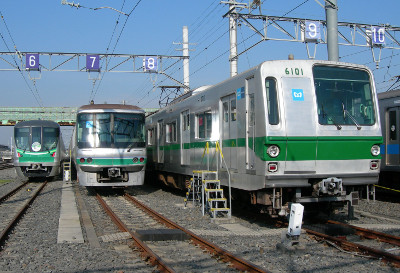
A lineup of Chiyoda Line rolling stock: 16000 Series, 06 Series, 6000 Series
The Tokyo Metro Chiyoda Line (東京地下鉄千代田線 Tōkyō Chikatetsu Chiyoda-sen) is a rapid transit line owned and operated by Tokyo Metro in Tokyo, Japan.
Overview
The 21.9 km main line serves the wards of Adachi, Arakawa, Bunkyō, Chiyoda, Minato and Shibuya, and a short stretch of tunnel in Taitō with no station. A 2.1 km branch line between Ayase and Kita-Ayase is located in Adachi. Its official name, rarely used, is Line 9 Chiyoda Line (9号線千代田線 kyūgō sen Chiyoda-sen).
On maps, diagrams and signboards, the line is shown using the color green, and its stations are given numbers using the letter "C".
Trains have through running onto other railway lines on both ends. More than half of these are trains to the northeast beyond Ayase onto the East Japan Railway Company (JR East) Joban Line to Toride. The rest run to the southwest beyond Yoyogi-Uehara onto the Odakyū Odawara Line to Hon-Atsugi and to Karakida on the Odakyu Tama Line.
According to the Tokyo Metropolitan Bureau of Transportation, as of June 2009 the Chiyoda Line was the second most crowded subway line in Tokyo, at its peak running at 181% capacity between Machiya and Nishi-Nippori stations.
History
The Chiyoda Line was originally proposed in 1962 as a line from Setagaya in Tokyo to Matsudo, Chiba; the initial name was "Line 8". In 1964, the plan was changed slightly so that through service would be offered on the Joban Line north of Tokyo, and the number was changed to "Line 9".
Line 9 was designed to pass through built-up areas in Chiyoda, and also intended to relieve the busy Ginza Line and Hibiya Line, which follow a roughly similar route through central Tokyo.
The first stretch was opened on December 20, 1969 between Kita-Senju and Ōtemachi. The line was almost completed by October 10, 1972 when it reached Yoyogi-Kōen, although the 1 km section to Yoyogi-Uehara was not completed until March 31, 1978. The branch line to Kita-Ayase was opened on December 20, 1979.
On May 15, 2006, women-only cars were introduced on early-morning trains from Toride on the Joban Line to Yoyogi-Uehara.
From March 18, 2008, Odakyu Romancecar limited express services began running between Kita-Senju and Hakone-Yumoto (on the Hakone Tozan Line) and Karakida (on the Odakyu Tama Line). Trains also run from/to Shin-Kiba using tracks connecting to the Yurakucho Line. It is the first time that reserved-seating trains have operated on a Japanese subway line.
Stations
Here is the station list of the Chiyoda Line from Yoyogi-Uehara (for transfers to other lines look at the page of the station).
- Yoyogi Uehara
- Yoyogi Koen
- Meiji Jingumae (Harajuku)
- Omotesando
- Nogizaka
- Akasaka
- Kokkai Gijidomae
- Kasumigaseki
- Hibiya
- Nijubashimae
- Otemachi
- Shin Ochanomizu
- Yushima
- Nezu
- Sendagi
- Nishi Nippori
- Machiya
- Kita Senju
- Ayase
- Kita Ayase (Branch Line)
Current Rolling Stock
Listed below are currently used, all are 10-car formations unless otherwise indicated. Numbers in parentheses are of formations currently in service.
Tokyo Metro 05 Series 3-car trains (x4) (since April 2014, used on Kita-Ayase Branch)
Tokyo Metro 06 Series (x1) (since 1993)
Tokyo Metro 07 Series (x1) (since 2008)
Tokyo Metro 6000 Series (x35) (since 1971)
Tokyo Metro 16000 Series (since November 2010)
Odakyu 1000 Series
Odakyu 4000 Series (since September 2007)
Odakyu 60000 Series MSE (since spring 2008)
JR East 209-1000 Series (x2)
JR East E233-2000 Series (since summer 2009)
Yūrakuchō Line
The Tokyo Metro Yūrakuchō Line (有楽町線 Yūrakuchō-sen) is a subway line owned and operated by Tokyo Metro. The line connects Wakōshi Station in Wakō, Saitama and Shin-Kiba Station in Kōtō, Tokyo. On maps, diagrams and signboards, the line is shown using the color "gold", and its stations are given numbers using the letter Y.
The proper name as given in an annual report of the Ministry of Land, Infrastructure and Transport is Line No. 8 Yūrakuchō Line (8号線有楽町線 Hachi-gō-sen Yūrakuchō-sen). According to the Tokyo urban transportation plan, however, it is more complicated. The line number assigned to the section south from Kotake-Mukaihara to Shin-Kiba is Line 8, but that of north of Kotake-Mukaihara to Wakōshi is Line 13, which indicates the section is a portion of Fukutoshin Line which shares the same number.
Services
The Yūrakuchō Line has inter-running counterparts on its northern side, both of which are "major" Japanese private railway companies in Greater Tokyo. One is the Tōbu Railway at Wakōshi, north to Shinrinkōen. The other is the Seibu Railway at Kotake-Mukaihara with its bypass line Seibu Yūrakuchō Line connecting to its main Ikebukuro Line, through trains north to Kotesashi or Hannō.
According to the Tokyo Metropolitan Bureau of Transportation, as of June 2009 the Yūrakuchō Line is the fifth most crowded subway line in Tokyo, at its peak running at 173% capacity between Higashi-Ikebukuro and Gokokuji stations.
Semi-express (準急) services ran on the Yūrakuchō Line between June 14, 2008 and March 6, 2010, operating twice hourly between Wakōshi and Shin-Kiba. Between Wakōshi and Ikebukuro, semi-express trains stopped only at Kotake-Mukaihara; between Ikebukuro and Shin-Kiba, trains stopped at all stations. The semi-express trains ran between rush hours during weekdays and more frequently on weekends and holidays. These services were abolished and replaced with local services on March 6, 2010.
Depots
Wakō Depot (和光検車区) (main depot)
Shin-Kiba Depot (新木場検車区) (responsible for minor inspections; for major ones, EMUs are forwarded to the Ayase Depot (綾瀬車両基地) on the Chiyoda Line via underground connecting tracks)
Shin-Kiba Car Renewal (新木場CR) (specializes in railcar refurbishment: also used for Chiyoda and Hanzōmon Line railcars)
History
- October 30, 1974: Ikebukuro - Ginza-itchōme opens.
- March 27, 1980: Ginza-itchōme - Shintomichō opens.
- June 24, 1983: Eidan Narimasu (present Chikatetsu Narimasu) - Ikebukuro
- October 1, 1983: Seibu Railway Seibu Yūrakuchō Line Kotake-Mukaihara - Shin-Sakuradai opened, through operation.
- August 25, 1987: Wakōshi - Eidan Narimasu. Through service to Tōbu Tōjō Line.
- June 8, 1988: Shintomichō - Shin-kiba, current line completed.
- March 18, 1993: 07 series EMUs introduced.
- December 7, 1994: Quadruple-track from Kotake-Mukaihara to Ikebukuro. New double track section was named "Yūrakuchō New Line", all trains made Ikebukuro their terminus, and did not stop at Senkawa nor Kanamechō. Through service from Shin-Kinba or Ikebukuro (on the New Line) to Nerima on Seibu Yūrakuchō Line due to completion of the line.
- March 26, 1998: Through operation to Seibu Ikebukuro Line .
- April 1, 2004: According to its privatization, the management subject changed from Teito Rapid Transit Authority (TRTA, Eidan) to Tokyo Metro.
- October 31, 2005: Women-only cars introduced.
- September 1, 2006: 10000 series introduced.
- May 3, 2008: Limited Express "Bay Resort" (operated first from/to Odakyu Line)
- June 14, 2008: Tokyo Metro Fukutoshin Line began service. Yurakuchō New Line annexed to a part of Fukutoshin Line, and Yurakuchō Line share double tracks with Fukutoshin Line between Wakōshi and Kotake-Mukaihara. Semi-Express service started.
- October 2008: CS-ATC enabled on the Yurakuchō Line.
- March 6, 2010: Semi-express services abolished.
Stations
Here is the station list of the Yurakucho Line from Wakoshi (for transfers to other lines look at the page of the station).
- Wakoshi
- Chikatetsu Narimasu
- Chikatetsu Akatsuka
- Heiwadai
- Hikawadai
- Kotake Mukaihara
- Senkawa
- Kanamecho
- Ikebukuro
- Higashi Ikebukuro
- Gokokuji
- Edogawabashi
- Iidabashi
- Ichigaya
- Kojimachi
- Nagatacho
- Sakuradamon
- Yurakucho
- Ginza Itchiome
- Shintomicho
- Tsukishima
- Toyosu
- Tatsumi
- Shin Kiba
Current Rolling Stock
All types are operated as 10-car sets.
Tokyo Metro 7000 series (from 1974)
Tokyo Metro 10000 series (from September 2006)
Seibu 6000 and 6050 series (Not all sets are permitted to run on Yūrakuchō Line tracks)
Tobu 9000 series x 8
Tobu 9050 series x 2
Tobu 50070 series (from July 2007)
Odakyu 60000 series MSE (Romancecar, as Limited Express Bay Resort, occasionally)
Tokyu 5050-4000 series 10-car trains (since 10 September 2012)
Hanzōmon Line
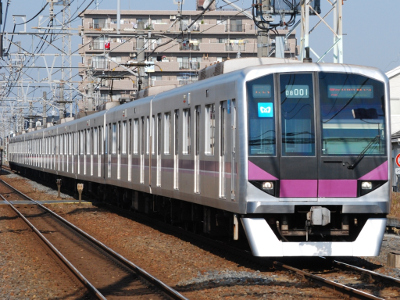
A Tokyo Metro 08 series EMU at Ichinowari Station on the Tobu Skytree Line
The Tokyo Metro Hanzōmon Line (東京地下鉄半蔵門線 Tōkyō-chikatetsu-hanzōmon-sen) is a subway line in Tokyo, Japan, owned and operated by Tokyo Metro.
Overview
The 16.8 km line serves the wards of Shibuya, Minato, Chiyoda, Chūō, Kōtō, and Sumida. The Hanzōmon Line is connected to the Tōkyū Den-en-toshi Line at Shibuya Station to the south, and to the Tobu Skytree Line at Oshiage to the north. Through trains operate between Chūō-Rinkan on the Tōkyū Den-en-toshi Line and Tōbu-Dōbutsu-Kōen on the Tobu Skytree Line, onward to Kuki on the Tobu Isesaki Line and Minami-Kurihashi on the Tobu Nikko Line. Through-service trains between Chūō-Rinkan and Minami-Kurihashi cover a total distance of 98.5 km in a single run.
The Hanzōmon Line has interchanges with all other Tokyo Metro and Toei lines except the Tokyo Metro Hibiya Line (although transfers are possible via the Tobu Skytree Line through service at Kita-Senju Station). It connects with the Tokyo Metro Ginza Line at five stations (the four stations between Shibuya and Nagatachō, as well as at Mitsukoshimae Station.
The line is named after the west gate of the Imperial Palace (Hanzōmon), which in turn is named after 16th century samurai Hattori Hanzō, who was important to the founding of the shogunate which built the palace. The Hanzōmon Line's color on maps and station guides is purple, and stations carry the prefix "Z" followed by a number.
According to the Tokyo Metropolitan Bureau of Transportation, as of June 2009 the Hanzōmon Line is the sixth most crowded subway line in Tokyo, at its peak running at 173% capacity between Shibuya and Omotesandō stations.
History
The Hanzōmon Line was first planned in 1971, along with the Chiyoda Line and Yūrakuchō Line, as a reliever line for the heavily congested Ginza Line. Its initial routing was from Futako-Tamagawa Station on the Tōkyū Den-en-toshi Line to a new station in the Fukagawa district of Kōtō Ward. In 1985, a second draft plan from the Ministry of Transportation moved the Hanzōmon Line's final terminus to Matsudo, Chiba Prefecture. During the planning stage, it was known as Line 11.
Construction began in 1972 and most of the line was expected to open in 1975. However, the poor economy in Japan had depressed the Teito Rapid Transit Authority's receipts during that time, which considerably delayed the construction of new lines. On August 1, 1978, the first section of the Hanzōmon Line opened from Shibuya to Aoyama-itchōme, and through service with the Den-en-toshi Line commenced.
The line was extended to Nagatachō in September 1979 without major incident. However, the next extension posed political problems, as the original plan had the line run directly under the Imperial Palace to Ōtemachi. TRTA decided to divert the route around the north side of the Imperial Palace, which required the construction of three new stations. An eminent domain battle erupted with landowners along the proposed route, which delayed the completion of the next stage of the line. Hanzomon Station opened in December 1982, and the full extension around the Imperial Palace, terminating at Mitsukoshi-mae, was completed in January 1989.
Since then, there have been further extensions to Suitengu-mae (November 1990) and finally Oshiage (in March 2003). The Ministry of Transportation estimated in 2000 that the line would be completed (i.e. extended to Matsudo) in 2015. However, Tokyo Metro stated in its initial public offering that its construction operations would cease once the Fukutoshin Line is completed, which casts some doubt as to whether the Matsudo extension will actually be built.
Stations
Here is the station list of the Hanzomon Line from Shibuya (for transfers to other lines look at the page of the station).
- Shibuya
- Omotesando
- Aoyama Itchome
- Nagatacho
- Hanzomon
- Kudanshita
- Jimbocho
- Otemachi
- Mitsukoshimae
- Suitengumae
- Kiyosumi Shirakawa
- Sumiyoshi
- Kinshicho
- Oshiage
Current Rolling Stock
Tokyo Metro 8000 series
Tokyo Metro 08 series
Tokyu 2000 series
Tokyu 5000 series
Tokyu 8500 series
Tokyu 8590 series
Tobu 30000 series
Tobu 50050 series
Namboku Line
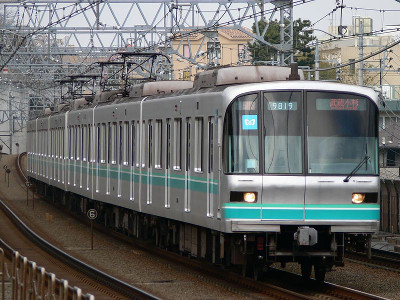
A Tokyo Metro 9000 series EMU near Tamagawa Station on the Tokyu Meguro Line
The Namboku Line (南北線 Nanboku-sen, "South-North Line") is a subway line owned and operated by Tokyo Metro in Tokyo, Japan. Its name literally means South-North Line. The line runs between Meguro in Shinagawa and Akabane-Iwabuchi in Kita. The Namboku Line was referred to as Line 7 during the planning stages, thus the seldom-used official name is Line 7 Namboku Line (7号線南北線 Nana-gō-sen Namboku-sen).
Overview
Trains run through onto the Tokyu Meguro Line for Hiyoshi and the Saitama Railway's Saitama Rapid Railway Line for Urawa-Misono. The portion between Shirokane-Takanawa and Meguro is shared with the Toei Mita Line.
The right-of-way and stations between Shirokane-Takanawa and Meguro are shared with the Toei Mita Line. Under an agreement between Tokyo Metro and the Tokyo Metropolitan Government, the fare for this section is calculated on the Toei fare system for passengers traveling to stations on the Mita Line past Shirokane-Takanawa, on the Metro fare system for passengers traveling to stations on the Namboku Line past Shirokane-Takanawa, and on the system "most beneficial to the passenger" (presently the Metro schedule) for travel solely on the shared sector.
On maps, diagrams and signboards, the Namboku Line is shown using the color "emerald", and its stations are given numbers using the letter "N".
History
The 21.3 km Namboku Line is one of Tokyo Metro's newest lines, featuring advanced technology including full automatic train operation and platform screen doors. Although the line was originally proposed in 1968, construction did not begin until the 1980s, partly due to the right-of-way to Meguro with the Toei Mita Line. The first segment from Komagome to Akabane-Iwabuchi opened on November 29, 1991.
The line initially operated with four-car EMUs. Upon its extension to Yotsuya in March 1996, the formations were extended to six cars. All stations are able to accommodate eight-car trains, but this length is not yet used.
The extension to Tameike-Sannō was completed in September 1997, and the last stretch from Tameike-Sanno to Meguro was completed on September 26, 2000, when through service to the Tokyu Meguro Line started. Through service with the Saitama Rapid Railway line commenced when it opened in March 2001 and accommodated traffic to and from Saitama Stadium during the 2002 World Cup.
Stations
Here is the station list of the Namboku Line from Meguro (for transfers to other lines look at the page of the station).
- Meguro
- Shirokanedai
- Shirokane Takanawa
- Azabu Juban
- Roppongi Itchome
- Tameike Sanno
- Nagatacho
- Yotsuya
- Ichigaya
- Iidabashi
- Korakuen
- Todaimae
- Hon Komagome
- Komagome
- Nishigahara
- Oji
- Oji Kamiya
- Shimo
- Akabane Iwabuchi
Current Rolling Stock
Tokyo Metro 9000 series 6-car EMUs
Saitama Rapid Railway 2000 series 6-car EMUs
Tokyu 3000 series 6-car EMUs
Tokyu 5080 series 6-car EMUs
Fukutoshin Line
The Tokyo Metro Fukutoshin Line (東京地下鉄副都心線 Tōkyō Chikatetsu Fukutoshin-sen), formally the No. 13 Fukutoshin Line (13号線副都心線 Jūsangō-sen Fukutoshin-sen), is a Tokyo Metro subway line in west-central Tokyo, Japan. The newest line in the Tokyo subway network, it opened in stages between 1994 and 2008.
Overview
The Fukutoshin Line is the deepest metro line in Tokyo, with an average depth of 27 meters. At Shinjuku-sanchōme Station, the line passes under the Marunouchi and above the Shinjuku lines at a depth of 15 meters, with a gap of only 11 centimeters to the Shinjuku Line tunnel. The deepest section is at the immediately adjacent Higashi-Shinjuku Station, where the line goes down to 35 meters, partly due to an underground space reservation for a possible future extension of the Jōetsu Shinkansen to Shinjuku.
It is the second Tokyo Metro line to feature express services, after the Tōzai Line; however, unlike the Tōzai Line (where rapid services are only offered on the Tōyōchō – Nishi-Funabashi section), the Fukutoshin Line offers express services throughout the line, a first for Tokyo Metro. Express trains pass local trains at Higashi-Shinjuku, where additional tracks are installed for this purpose. Local trains stop at all stations.
Through services run to Kawagoeshi Station on the Tōbu Tōjō Line and Hannō Station on the Seibu Ikebukuro Line. From 16 March 2013, the Tōkyū Tōyoko Line moved to share the line's Shibuya terminus, enabling through services on the Minatomirai Line to Motomachi-Chūkagai Station in Yokohama.
Between Kotake-Mukaihara Station and Shibuya Station the Fukutoshin Line operates as a one-man operation subway line where waist-high platform edge doors are installed on the station platforms to aid the drivers.
Like most Tokyo Metro lines, the first carriage of the Fukutoshin Line is designated a "women only car" before and during the morning rush hour. During these hours only women, children of elementary school age or younger and physically disabled passengers (and their carers) may board the first carriage.
History
Fukutoshin is Japanese for "secondary city center", and the Fukutoshin Line connects three of Tokyo's secondary city centers: Ikebukuro, Shinjuku and Shibuya. Prior to its opening, only JR East had rail service between the three (on the Yamanote Line, the Saikyō Line and the Shōnan-Shinjuku Line). The new line was conceived to relieve congestion along this busy corridor, and to provide convenient through service between the northwest, the southwest and the central part of Tokyo served by the Yamanote Line.
The line was initially planned in 1972 as a run from Shiki, Saitama to Shinjuku, with the possibility of further extension to Shibuya, Shinagawa and Haneda Airport. In 1985, a second Ministry of Transportation committee proposed that the line terminate at Shibuya. Part of the northern end of the original plan line became unnecessary following improvements to the Tōbu Tōjō Line and the beginning of through service from the Yūrakuchō Line.
The original plan for the Fukutoshin Line only contained fifteen stations, however in May 1999 a plan for an additional station "Shin-Sendagaya" (later renamed Kitasandō) between Shinjuku-Sanchōme and Meiji-Jingūmae was included due to an increase in demand from the area.
A 3.2 km segment from Kotake-Mukaihara to Ikebukuro, running parallel to the Yūrakuchō Line on separate tracks began operation in 1994. This segment was initially known as the Yūrakuchō New Line (有楽町新線 Yūrakuchō Shin-sen), and was operated with no intermediate stops.
The newest segment connecting the districts of Shinjuku and Shibuya via Zōshigaya, Sendagaya and Harajuku opened for service on 14 June 2008, officially completing the Fukutoshin Line. Service to the Senkawa and Kanamechō stations, which had been bypassed by the Yūrakuchō New Line, also started on the same day. Technical problems resulted in delays of up to 30 minutes during the Fukutoshin Line's first few days of operation.
On 6 March 2010, express services began stopping at Meiji-Jingūmae Station on weekends and holidays.
From 10 September 2012, 10-car 5050-4000 series sets entered revenue service on the Tokyo Metro Fukutoshin Line, with inter-running through to the Seibu Ikebukuro Line (via Seibu Yurakucho Line) and Tobu Tojo Line.
Stations
Here is the station list of the Fukutoshin Line from Wakoshi (for transfers to other lines look at the page of the station).
- Wakoshi
- Chikatetsu Narimasu
- Chikatetsu Akatsuka
- Heiwadai
- Hikawadai
- Kotake Mukaihara
- Senkawa
- Kanamecho
- Ikebukuro
- Zoshigaya
- Nishi Waseda
- Higashi Shinjuku
- Shinjuku Sanchome
- Kitasando
- Meji Jingumae
- Shibuya
Current Rolling Stock
Tokyo Metro 7000 Series 8-car and 10-car trains
Tokyo Metro 10000 Series 10-car trains
Seibu 6000 Series 10-car trains
Seibu 6050 Series 10-car trains
Tobu 9000 Series 10-car trains
Tobu 9050 Series 10-car trains
Tobu 50070 Series 10-car trains
Tokyu 5050 Series 10-car trains
Tokyu 5050-4000 Series 10-car trains (since 10 September 2012)
Yokohama Minatomirai Railway Y500 Series 8-car trains (a Tokyu 5000 Series variant)

